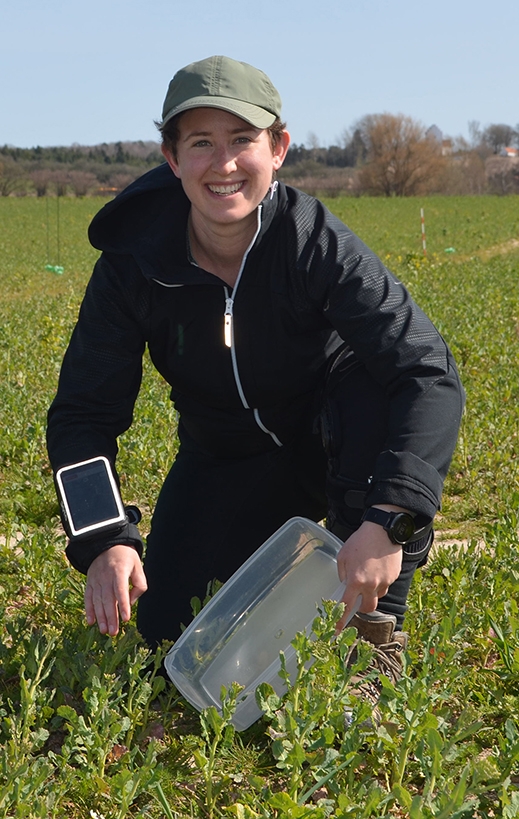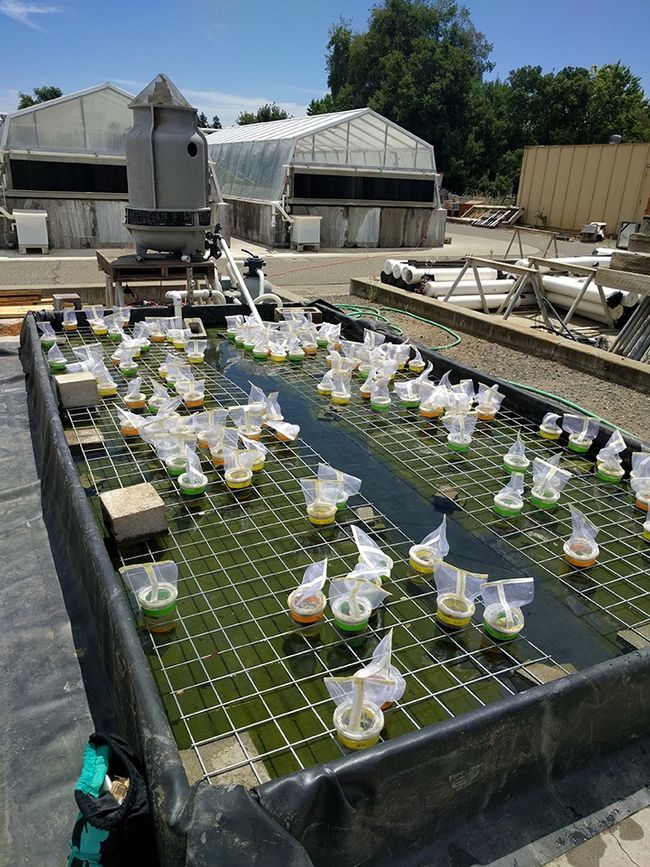
The paper appears in the current edition of Journal of Hydrobiologia.
“The water hyacinth, Eichhornia crassipes, isconsidered the world's most economically damaging aquatic weed,” said Bick, now a postdoctoral scholar at the University of Copenhagen, Denmark.
The free-floating perennial, native to the Amazon region of South America, is highly invasive throughout the world. It forms large floating mats when its roots and leaves intertwine. The aquatic weed is a major issue in the Sacramento-San Joaquin Delta in central California.
“This paper is the result of my first dissertation chapter,” said Bick, an agricultural entomologist who received both her master's degree (2017) and doctorate in entomology (2019) from UC Davis. “We aimed to determine if salinity was the reason N. bruchi was not effective at regulating the weed in the Sacramento-San Joaquin Delta compared with other worldwide locations. The results were not as clear cut as we hoped, as the study was limited in testing only adult weevils. However, the paper makes the case for including salinity as a screening variable for new biological control agents that are candidates for release in the Delta and other partially saline areas. Also, given the thoroughness of the experiments, there is at least one cool modeling paper to come out as a follow-up.”
The paper, titled “Effects of Salinity and Nutrients on Water Hyacinth and its Biological Control Agent, Neochetina bruchi, “was truly an all-hands-on-deck effort,” Bick said. "Specifically, a major project hurdle was the temperature in Davis."
She related that the greenhouse experiments on water hyacinth “weren't producing consistent results due to the high variation—and high heat--in water temperature.” So fellow scientists Danny Klittich, then a UC Davis doctoral student in entomology with the Michael Parrella laboratory, and Bob Starnes, then UC Davis senior superintendent of agriculture, built a giant water bath out of a leftover evaporative cooler from the Parrella lab.
Klittich is now the California Central Coast Agronomist with Redox Chemicals and chief executive officer and founder at HowToGrowRoses.org. Starnes is vice president of agriculture for UAV-IQ (Unmanned Aerial Vehicle Intelligence.
In addition to Klittich and Starnes, other co-authors are UC Davis postdoctoral scholar Elvira deLange of the Christian Nansen lab; then doctoral student Cindy Kron of the Frank Zalom laboratory; and undergraduate students Jessie Liu and Derrick Nguyen. Kron, now with UC Cooperative Extension, is the North Coast Area Integrated Pest Management (IPM) Advisor, serving Sonoma, Napa, Mendocino and Lake counties.
The abstract:
“Water hyacinth, Eichhornia crassipes (Mart.) Solms (Commelinales: Pontederiaceae), is an important aquatic weed worldwide. Previous studies demonstrate that releases of Neochetina bruchi Hustache (Coleoptera: Curculionidae) provide biological control in many locations, but not all. Notably, N. bruchi were unsuccessful at regulating water hyacinth in tidal brackish waters. Abiotic factors, including salinity and nutrients, affect water hyacinth growth, but little is known about the impact of salinity on weevil survival. We hypothesized that N. bruchi has a relatively low salinity tolerance. In a mesocosm experiment, we assessed weed growth in response to a range of salinity and nutrient concentrations. In a laboratory, we assessed adult N. bruchi mortality in response to various salinity concentrations. Results indicate that increasing nutrient concentration increases weed growth. When both nutrient and salinity levels were varied, nutrients increased leaf count, but not biomass, while salinity reduced growth and increased mortality. Increasing salinity concentrations increased adult weevil mortality; required concentrations were higher than that for weeds. Thus, these results did not provide support for the suggested hypothesis. Potential effects of salinity via other exposures to weevils need to be investigated. Elucidating abiotic factors important for weed growth and weevil survival may increase effectiveness of water hyacinth management practices.”
The water hyacinth was introduced in California in 1904. Scientists trace its history in the United States back to 1884 at the New Orleans Exposition. “Samples are said to have been given to fair-goers, and within 4 years, coastal fresh waters were infested from Texas to Alabama. By 1972, the infestation in Florida was estimated to be 200,000 acres,” according to Cornell University. “Large, floating mats of waterhyacinth obstruct navigation, clog irrigation works, disrupt the natural ecology of wetlands in many ways, exacerbate mosquito problems, and are costly to the tourism and recreation industries.”
Two biocontrol agents, weevils N. eichhorniae and N. bruchi, natives of Argentina, and surrounding areas in South America, were released in 1972 and 1974, respectively.
Attached Images:
